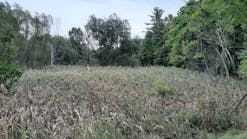Controlling sediment from disturbed earth to prevent it from leaving a project site is an essential part of responsible land development. In an increasingly regulated world, federal, state, and local laws mandate that it be done using recognized best management practices (BMPs).
Starkey Ranch
Land development has been a factor in Florida’s economy since the early years of the 20th century. The state’s warm climate and natural beauty continue to attract residents from other states.
Fortunately, the land is being developed much more carefully than it was years ago. Regulations require—and new home customers want—developers to protect the environment.
To meet housing and other demands from a growing population, Florida land that was once used for agriculture is being sold for development. In some cases, the land has been held in the same family for generations.
In the 19th and early 20th centuries, Florida was known for its cattle ranches nearly as much as was Texas. One of these large working ranches was created and run by the Starkey family. They raised Brahman cattle and also had citrus groves.
At its peak, the Starkey Ranch covered more than 18,000 acres in southwest Pasco County. When J.B. Starkey Jr., the son of its founder, decided to sell most of the ranch, he remembered what had happened to the first ranch his father had owned and sold because encroaching development made expansion impossible.
Not wanting to see this much larger family ranch turned into strip malls and cluttered areas, Starkey set aside most of the ranch land. He created a natural preserve that could never be developed.
The J.B. Starkey Wilderness Park preserved the wild natural Florida that he remembered roaming as a boy. The park’s three tracts of the former ranch land total some 16,000 acres. About 8,500 acres of the area is a wetland ecosystem.
Future generations of Floridians who would live on the parts of the ranch land that would be developed would have easy access to this pristine preserve, which is also open to the public. They could enjoy the natural beauty of rural Florida that the Starkey family knew well.
That philosophy has been carried on by J.B. Starkey’s children in the land that they have sold for development, which is about 28 miles north of the city of Tampa. Of the more than 2,400 acres of land available, only about 1,300 acres will be developed.
Development has in some ways actually improved the wildlife habitat. Land that was pasture for the Starkeys’ cattle has been turned into required stormwater ponds and other wetlands areas. Now roseate spoonbills, cranes, and other water birds have settled there for birdwatching residents to enjoy.
Development of the Starkey Ranch land began in early 2015. The work is being done in phases and will continue until late 2020.
RIPA & Associates of Tampa, FL, is doing the site work for all phases of the development. That includes installation of roads, utility lines, storm and sanitary sewers, stormwater ponds, and other features that must be completed before construction can begin.
Starkey Ranch includes a tributary of the Anclote River. Wetland areas and creeks meander off of it in different sections of the property.
Challenges to the development project include “working in close proximity to wetland areas,” explains Ben Buttelman, environmental manager with RIPA. “And there are a lot of areas [within the property] that would be flooded at certain times of the year.”
He adds, “Florida is a very diverse environment. It’s not easy to develop land here.”
And then there is the challenge of working during Florida’s rainy season, which extends from mid-May until about November.
“The rainy season is challenging on a daily basis,” says Buttelman. “Weather has slowed down operations. You have to work together to come up with a plan to keep the work going and make sure we’re staying in compliance and protecting the environment. A lot of planning goes on before action begins.”
He adds, “The state agencies do routine inspections at random times. The county inspectors, on average, are here onsite weekly, but they could be here several times in a week.”
One of the reasons RIPA won this major project contract is the firm’s reputation for keeping work in compliance while sticking to the schedule. RIPA now has more than 900 employees, with over 80 active job sites. The company’s environmental division has grown from one employee to more than 30.
“We take a proactive approach [to protecting the environment] at RIPA. Some of the regulatory agencies look to us for standards of what they like to see. They see a strong effort to stay in compliance. We spend more money and time upfront. That definitely saves money and time in the long run,” explains Buttelman.
He says RIPA has “tried to create a culture around the environmental side of things, where it’s a standard you don’t have resistance to taking steps to protect the environment. Ultimately, that makes everyone’s job easier.”
He adds, “It’s policy now, rather than ‘Here’s an idea we might use.’ We’re in the forefront of creating an environmental culture. The environmental regulatory agencies are watching more now because of the vast amount of development in Florida.”
One of the BMPs that the RIPA team relies on for protecting the perimeter of construction sites is high-quality silt fencing. The brand the company uses is made by Silt-Saver of Conyers, GA.
“It’s a much stronger, better product. It’s been abused by the end of a job, but it stays intact so long. It could be there five months,” notes Buttelman.
The Starkey Ranch project uses “up to 10 pallets a month of Silt-Saver, a combination of three different products—the BSRF Priority 1, the BSRF Priority 2, and the WBSF, depending on the type of dirt and the amount of slope in a particular site,” explains Buttelman.
He adds, “Silt-Saver saves us time and money. To have it installed gives us peace of mind.”
Harvest at Limoneira
Limoneira means “lemon farm” or “lemon plantation” in Portuguese. It is an appropriate name for the company that grows more lemons than any other grower in the world. Limoneria, founded in 1893, also grows several types of oranges, avocados, pistachios, cherries, and pluots (a cross between a plum and an apricot) in its vast acreage of groves in Ventura County, CA.
Besides growing and packing citrus fruits and other crops, the company also has an active real estate division, which is involved in creating mixed-used land developments. One of those developments is Harvest at Limoneira. This 550-acre master-planned community is located in Santa Paula, CA. Harvest at Limoneira will have both residential and commercial space.
Sustainable practices have long been a part of Limoneira’s production of lemons and other crops. The company set aside 10 acres to receive green materials (lawn clippings, branches, etc.) from throughout Ventura County. These materials are recycled into mulch that is spread in the orchards to stop erosion, improve water efficiency, reduce weeds, and moderate soil temperatures.
Limoneira has several solar installations, including a 5.5-acre photovoltaic orchard at its headquarters in Santa Paula. When the additional solar installation on top of the packing house roof is finished, half of the company’s energy needs will be generated off the grid.
Water and soil moisture probes transmit data used to control the irrigation systems to help the company conserve water and use it wisely. This attention to detail also improves crop production.
In 1928, Limoneira helped found Associates Insectary. This grower-owned cooperative provides complete pest control services to commercial citrus and avocado farmers. Its sustainable emphasis is on using beneficial insects to control destructive agricultural pests.
Limoneira’s focus on sustainable practices in agriculture has continued in the company’s real estate development. For the Harvest at Limoneira project, Landscape Development of Santa Clarita, CA, and other cities is responsible for sustainable BMPs in site development, design, erosion control, and other aspects of the project.
Amy Ambrose, president of Landscape Development’s Earth Sciences Division, says the firm has been involved with the Limoneira project for several years. “We did the design work in 2009 and 2010, and we’ll be on the project for another five to six years,” she says.
“California in general is very strict about environmental compliance. When a site is [considered to be] higher risk level, [the agencies] are definitely stricter. This is a Risk Level 2 site. When we have sites with higher risk, like this one, we tend to use better products, even if they’re more expensive,” she explains.
Accordingly, SiltSoxx are applied around catch basins and in different critical areas where samples of the runoff are taken. These compost-filled socks are made by Filtrexx of Akron, OH.
The California Construction General Permit requires that samples of runoff be taken for pH, turbidity, and other parameters. Ambrose says that those requirements must be met for work to be allowed to continue. “This site is high profile because it’s so large,” she adds.
To protect the Santa Clarita watershed, other erosion control BMPs used during construction of Harvest at Limoneira include “darn near everything,” says Ambrose. “We have silt fence, straw wattles, spillways of plastic and gravel bags [14- by 26-inch woven poly bags with clean 3/4-inch gravel], check dams, and velocity redirects, and we’ve hydroseeded for stability.”
Another erosion control product that Landscape Development crews are using at Harvest at Limoneira is EarthGuard Fiber Matrix from Terra Novo of Bakersfield, CA, which is now partnered with LSC Environmental Products.
“We spray this mulch and heavy tackifier product on the bare lots to protect them [from losing soil while they wait for construction to begin]. In some areas we add a seed mixture, too,” says Ambrose. “The EarthGuard is a very good mix to stabilize those bare areas.”
Another BMP undertaken to control sediment in stormwater runoff at Harvest at Limoneira are the stormwater detention ponds. These ponds are temporary, in place only during construction.
“We’ve built several detention basins for the project,” says Ambrose. “They’re sprayed and hydroseeded and typically are there during the winter season.”
Clearing the site in stages as needed is another standard practice for controlling sediment that Land Development is following. Ambrose notes, “With the restrictions we have in California, this is safer for us [to work this way], especially on large projects like this one.”
She says her division has had a four-person crew working on different BMPs at the Limoneira development for two years “unless it rains. Then we call out more people, even on the weekends, so there is never any water pouring off of the site.”
The erosion control crew members “do cleanup, housekeeping. It’s a never-ending process.”
Sampling of the runoff is also done during storms. The construction permit requires it for a Risk Level 2 site.
On a development of the size of Harvest at Limoneira, involvement of personnel from the regulatory agencies is not only expected but really a routine matter. Ambrose says meetings with inspectors from the city and county occur at least once a week.
“They’ve been working directly with the developer, which makes everyone’s life easier,” she adds.
The permit requires inspections “prior to, during, and after rain events. When they come prior to the rain event they tell the crew, ‘You need to do these BMPs.’ Then they monitor how well the BMPs worked. Under the California General Construction permit you’re required to have all three inspections done [for each rain event],” explains Ambrose.
As far as dealing with local wildlife during construction, she says, “We have some restrictions to species, certain areas we have to patrol. Very rarely do we work where there aren’t some species that are protected.”
Before site development could begin, a biologist inspected the property and prepared a report that is part of the general permit for development. Deer and fox are two of the main types of wildlife in the area, along with different birds.
“If it’s nesting season and we see a nest, that area is off limits for work until the birds leave,” explains Ambrose.
Building in Louisiana
Through their Louisiana erosion control services firm Stormwater Solutions Louisiana, Mario Pacetti and his partner Blake Hines keep busy controlling sediment on construction sites in numerous subdivisions. The construction company building these subdivisions is one of the largest homebuilders in the US.
“This homebuilder was spending large amounts of money to replace silt fencing that was torn out by trucks,” says Pacetti. “Reburying silt fence is a disaster. You won’t get that compaction the second time you do it.”
Pacetti recommended that the company let him try a different product instead of continuing to use silt fencing. “We did a demo of 20,000 feet of Gator Guard [wattles] for them. They liked it.”
Pacetti adds that the wattle is “more expensive [than silt fencing] but it can be reused. We pressure-wash it at our facility. We’ve been able to recycle about 85% of what we’ve put down.”
Now the Stormwater Solutions Louisiana crews are using the sediment control wattles on various developments for the homebuilder. Manufactured by Gator Guard Environmental Products of Boise, ID, the wattles are made of UV-resistant geotextile stuffed with photodegradable closed-cell recycled foam.
Gator Guard’s Standard Wattle has foam pieces. The company’s Extreme Wattle consists of 6- by 50-inch rolled foam logs. Tests at San Diego State University showed that the wattles are 98% effective at keeping sediment in place, compared to 50% effectiveness for straw wattles. Pacetti notes, “I can show these test results to my customers.”
His crews find that their work is going faster when they use the wattles. They don’t have to go back and replace fencing that has been torn down by wind or trucks.
“We generally keep 3,000 feet of Gator Guard in stock and generally put 2,000 feet down at a time when we start a project,” he explains.
He likes to use the Extreme Gator Guard behind the curbs on lots. “It’s designed to be driven over. Gator Guard makes a weighted product for [keeping sediment out of] drains. We get four to five inches of rain hitting the ground in a couple of hours. The Gator Guard is heavy enough to stay in place but not cause flooding back into the lots.”
Pacetti’s crews use the product only on sites with curbs.On developments where the streets run alongside open ditches, “We stabilize them with erosion control mats, hydroseed the ditches, and add silt fences.”
The company is also performing erosion control work on a residential development project in Slidell, LA, and using Gator Guard products there, too.
“It’s a beautiful project,” says Pacetti. “They’re releasing12 homes a week on it. Construction is going on at 100 homes in this subdivision at the same time.”
He says, “We generally put silt fencing in first—that’s the regulators’ call—then, when the silt fencing gets damaged, we put Gator Guard down for the duration.”
His crews’ responsibilities “run to the last part, grading. The Gator Guard stays in place until grass is growing. The homebuilder is all about making sure everything stays clean. They do not want a work stoppage that we can control, so the municipal officials are happy to work with them.”
Work on the Slidell development started in spring 2018 and will continue for the next five years. Pacetti says the current homebuilder bought the first 30 or so houses that had already been constructed by another developer as well as 12,000 acres of additional land to develop.
“There’s a levee around it. It’s a self-contained community,” he explains.
As in other states, inspectors show up on construction sites regularly. “We get a stormwater report once a week. We have to correct [anything the inspectors mention] and make sure the drains are clean,” he says.
The homebuilding firm’s development in Hammond, LA, is another project for which Stormwater Solutions Louisiana is providing sediment control. Work began in late summer 2018 and will finish mid-summer of this year. Pacetti takes pride that there have been no work stoppages for erosion control reasons, because the city of Hammond is “very strict.”
Pacetti says his sediment control crews “are the dishwashers on a job site. We’re just a flat expense on a project, so our goal is to price for long-term relationships.”
One of the challenges of keeping construction sites clean to protect the environment is that construction workers in various trades “disregard what we do. The brickers and framers don’t care about stormwater. They don’t understand our work. Sometimes we put BMPs in place and the other contractors will tear them up,” laments Pacetti.
Fortunately, the homebuilding firm “sees that the bigger picture is compliance. They require us to have crews there every day to pressure-wash, sweep, clean the roads.”
Pacetti says that his company’s well-trained crew members know that “our job is to protect our customer from an EPA audit or having a work stoppage. A stormwater work stoppage will prevent all of the other contractors from working.”
The homebuilder has given Stormwater Solutions Louisiana so much erosion control work, he says, “We’ve had to open an office in Walker, LA, with two full-time crews.”








